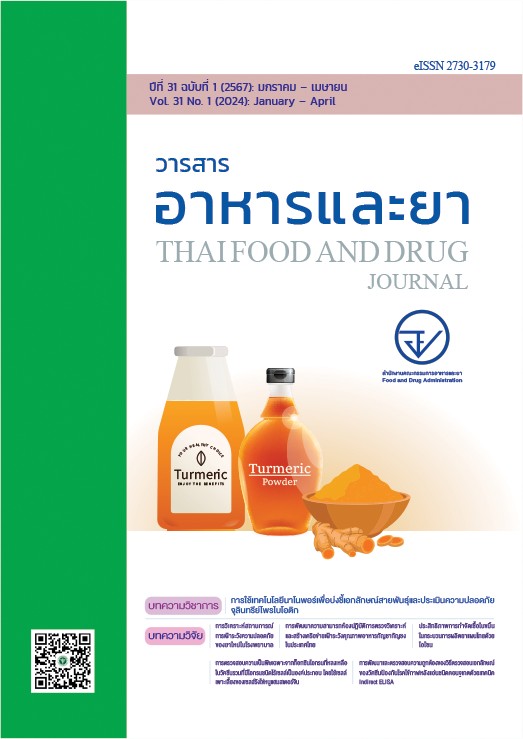การพัฒนาความสามารถห้องปฏิบัติการตรวจวิเคราะห์ และสร้างเครือข่ายเฝ้าระวังคุณภาพอาหารกัญชากัญชงในประเทศไทย
Main Article Content
บทคัดย่อ
ความสำคัญ: การเฝ้าระวังและควบคุมคุณภาพอาหารที่มีกัญชากัญชงเป็นส่วนประกอบให้ได้มาตรฐานเพื่อคุ้มครองผู้บริโภคจำเป็นต้องอาศัยการตรวจวิเคราะห์จากห้องปฏิบัติการ และวิธีการตรวจวิเคราะห์ถือเป็นประเด็นสำคัญที่ส่งผลต่อประสิทธิภาพการเฝ้าระวังโดยตรง
วัตถุประสงค์: พัฒนาขีดความสามารถห้องปฏิบัติการสำนักคุณภาพและความปลอดภัยอาหาร
กรมวิทยาศาสตร์การแพทย์ และศูนย์เครือข่ายครอบคลุมทั้ง 4 ภูมิภาค
วิธีการวิจัย: พัฒนาวิธีวิเคราะห์สารกลุ่มแคนนาบินอยด์ในอาหารตามที่กฎหมายกำหนด จัดทำโครงการเพื่อพัฒนาหองปฏิบัติการเครือข่ายในส่วนภูมิภาค ติดตามประเมินผลการตรวจวิเคราะห์ด้วยการส่งตัวอย่างเปรียบเทียบผลระหว่างหองปฏิบัติการไปยังศูนย์เครือข่าย และจัดทีมนิเทศงานลงพื้นที่เพื่อแก้ไขปัญหา
ผลการศึกษา: ปี พ.ศ. 2564 สามารถพัฒนาวิธีวิเคราะห์สารกลุ่มแคนนาบินอยด์ในอาหารเพื่อรองรับประกาศกระทรวงสาธารณสุข ฉบับที่ 425 ครอบคลุมอาหารทั้ง 11 ประเภท และฉบับที่ 427, 428, 429, 437, 438 และ 439 และในปี พ.ศ 2565 ได้รับการขึ้นทะเบียนเป็นห้องปฏิบัติการที่ผ่านการรับรองความสามารถตามมาตรฐาน ISO/IEC 17025: 2017 ในขอบข่ายอาหารพร้อมบริโภค เครื่องดื่ม (ที่มีและไม่มีส่วนประกอบของส่วนของกัญชาหรือกัญชง) และพืชกัญชา กัญชง (สดและแห้ง ยกเว้นช่อดอก) เป็นแห่งแรกของประเทศไทย ต่อมาในปี พ.ศ. 2565-2566 ได้จัดทำโครงการเพื่อพัฒนาหองปฏิบัติการเครือข่ายในส่วนภูมิภาค จนขยายศักยภาพได้ครอบคลุมทั้ง 4 ภูมิภาคของประเทศไทย เพื่อรองรับการตรวจเฝ้าระวังและขึ้นทะเบียนอาหารในระดับท้องถิ่น ประเมินผลการตรวจวิเคราะห์ของหองปฏิบัติการเครือข่ายด้วยการส่งตัวอย่างเปรียบเทียบผลระหว่างหองปฏิบัติการในปี 2566 ซึ่งผลการวิเคราะห์ THC และ CBD อยู่ในเกณฑ์น่าพอใจ ร้อยละ 92.9 และ 92.3 ตามลำดับ ส่งเสริมเครือข่ายทั้ง 4 ภูมิภาคใหมีการพัฒนาความสามารถอย่างต่อเนื่องโดยการลงพื้นที่นิเทศงาน ให้คำปรึกษา และช่วยแก้ไขปัญหา
สรุป: จากผลการดำเนินการของโครงการดังกล่าว สามารถสร้างความคุ้มค่าสมประโยชน์ทั้งภาครัฐและเอกชน โดยสามารถขยายภารกิจการเฝ้าระวังคุณภาพและความปลอดภัยของอาหารไปยังระดับภูมิภาค รองรับปริมาณตัวอย่างที่ผลิตในระดับท้องถิ่น ขยายพื้นที่การให้บริการต่อผู้รับบริการ อีกทั้งได้ข้อมูลผลการตรวจวิเคราะห์ในภาพรวมของประเทศ (big data) สำหรับมาใช้วางแผนการเฝ้าระวังความปลอดภัยด้านอาหารอย่างต่อเนื่องและเป็นระบบ รวมถึงสื่อสารให้หน่วยงานที่เกี่ยวข้องนำข้อมูลไปใช้ประโยชน์ได้ต่อไป
Article Details

อนุญาตภายใต้เงื่อนไข Creative Commons Attribution 4.0 International License.
เอกสารอ้างอิง
บังอร ศรีพานิชกุลชัย. การใช้กัญชาเพื่อประโยชน์ทางการแพทย์. วารสารเภสัชศาสตร์อีสาน 2562;15(4):1-26.
Kapook.com. กัญชาในอาหาร กินแล้วจะเมาไหม กินได้แค่ไหนไม่อันตรายต่อสุขภาพ [อินเทอร์เน็ต]. [เข้าถึงเมื่อ 9 ก.ย. 2566]. เข้าถึงได้จาก: https://health.kapook.com/view241034.html
กระทรวงสาธารณสุข. ประกาศกระทรวงสาธารณสุข (ฉบับที่ 425) พ.ศ. 2564 เรื่องเมล็ดกัญชง น้ำมันจากเมล็ดกัญชง โปรตีนจากเมล็ดกัญชง และผลิตภัณฑ์อาหารที่มีส่วนประกอบของเมล็ดกัญชง น้ำมันจากเมล็ดกัญชง หรือโปรตีนจากเมล็ดกัญชง. ราชกิจจานุเบกษา ฉบับประกาศทั่วไป เล่มที่ 138, ตอนพิเศษ 49 ง (ลงวันที่ 4 มีนาคม 2564).
กระทรวงสาธารณสุข. ประกาศกระทรวงสาธารณสุข (ฉบับที่ 437) พ.ศ. 2565 เรื่องเมล็ดกัญชง น้ำมันจากเมล็ดกัญชง โปรตีนจากเมล็ดกัญชง และผลิตภัณฑ์อาหารที่มีส่วนประกอบของเมล็ดกัญชง น้ำมันจากเมล็ดกัญชง หรือโปรตีนจากเมล็ดกัญชง (ฉบับที่ 2). ราชกิจจานุเบกษา ฉบับประกาศทั่วไป เล่มที่ 139, ตอนพิเศษ 251 ง (ลงวันที่ 21 ตุลาคม 2565).
กระทรวงสาธารณสุข. ประกาศกระทรวงสาธารณสุข (ฉบับที่ 427) พ.ศ. 2564 เรื่อง ผลิตภัณฑ์อาหารที่มีส่วนประกอบของส่วนของกัญชาหรือกัญชง. ราชกิจจานุเบกษา ฉบับประกาศทั่วไป เล่มที่ 138,
ตอนพิเศษ 168 ง (ลงวันที่ 23 กรกฎาคม 2564).
กระทรวงสาธารณสุข. ประกาศกระทรวงสาธารณสุข (ฉบับที่ 438) พ.ศ. 2565 เรื่อง ผลิตภัณฑ์อาหารที่มีส่วนประกอบของส่วนของกัญชาหรือกัญชง (ฉบับที่ 2). ราชกิจจานุเบกษา ฉบับประกาศทั่วไป เล่มที่ 138, ตอนพิเศษ 251 ง (ลงวันที่ 21 ตุลาคม 2565).
กระทรวงสาธารณสุข. ประกาศกระทรวงสาธารณสุข (ฉบับที่ 429) พ.ศ. 2564 เรื่องผลิตภัณฑ์อาหารที่มีสารสกัดแคนนาบิไดออลเป็นส่วนประกอบ. ราชกิจจานุเบกษา ฉบับประกาศทั่วไป เล่มที่ 138,
ตอนพิเศษ 198 ง (ลงวันที่ 27 สิงหาคม 2564).
กระทรวงสาธารณสุข. ประกาศกระทรวงสาธารณสุข (ฉบับที่ 439) พ.ศ. 2564 เรื่องผลิตภัณฑ์อาหารที่มีสารสกัดแคนนาบิไดออลเป็นส่วนประกอบ (ฉบับที่ 2). ราชกิจจานุเบกษา ฉบับประกาศทั่วไป เล่มที่ 138, ตอนพิเศษ 251 ง (ลงวันที่ 21 ตุลาคม 2565).
กระทรวงสาธารณสุข. ประกาศกระทรวงสาธารณสุข (ฉบับที่ 428) พ.ศ. 2564 เรื่อง มาตรฐานอาหารที่มีสารปนเปื้อนชนิดสารเตตราไฮโดรแคนนาบินอล และสารแคนนาบิไดออล. ราชกิจจานุเบกษา ฉบับประกาศทั่วไป เล่มที่ 138, ตอนพิเศษ 168 ง (ลงวันที่ 23 กรกฎาคม 2564).
กระทรวงสาธารณสุข. ประกาศคณะกรรมการควบคุมยาเสพติดให้โทษ เรื่อง ห้องปฏิบัติการตรวจ วิเคราะห์เพื่อหาปริมาณสารเตตราไฮโดรแคนนาบินอล (Tetrahydrocannabinol, THC) ในกัญชง (Hemp) พ.ศ. 2564. ราชกิจจานุเบกษา ฉบับประกาศทั่วไป เล่มที่ 138, ตอนพิเศษ 30 ง (ลงวันที่ 8 กุมภาพันธ์ 2564).
Newton DE, editor. Marijuana A REFERENCE HANDBOOK. 2nd ed. California: ABC-CLIO; 2017.
กระทรวงสาธารณสุข. ประกาศกระทรวงสาธารณสุข เรื่อง ระบุชื่อยาเสพติดให้โทษในประเภท 5 พ.ศ. 2561. ราชกิจจานุเบกษา ฉบับประกาศทั่วไป เล่มที่ 135, ตอนพิเศษ 205 ง (ลงวันที่ 24 สิงหาคม 2561).
กระทรวงสาธารณสุข. ประกาศกระทรวงสาธารณสุข เรื่อง ระบุชื่อยาเสพติดให้โทษในประเภท 5 พ.ศ. 2562. ราชกิจจานุเบกษา ฉบับประกาศทั่วไป เล่มที่ 136, ตอนพิเศษ 218 ง (ลงวันที่ 30 สิงหาคม 2562).
กระทรวงสาธารณสุข. ประกาศกระทรวงสาธารณสุข เรื่อง ระบุชื่อยาเสพติดให้โทษในประเภท 5 พ.ศ. 2563. ราชกิจจานุเบกษา ฉบับประกาศทั่วไป เล่มที่ 137, ตอนพิเศษ 290 ง (ลงวันที่ 14 ธันวาคม 2563).
กระทรวงสาธารณสุข. ประกาศกระทรวงสาธารณสุข (ฉบับ 424) พ.ศ. 2564 เรื่อง กำหนดอาหารที่ห้าม ผลิต นำเข้า หรือจำหน่าย. ราชกิจจานุเบกษา ฉบับประกาศ ทั่วไป เล่ม 138, ตอนพิเศษ 45 ง
(ลงวันที่ 25 กุมภาพันธ์ 2564).
กระทรวงสาธารณสุข. ประกาศกระทรวงสาธารณสุข เรื่อง ระบุชื่อยาเสพติดให้โทษในประเภท 5 พ.ศ. 2565. ราชกิจจานุเบกษา ฉบับประกาศ ทั่วไป เล่มที่ 139, ตอนพิเศษ 35 ง (ลงวันที่ 9 กุมภาพันธ์ 2565).


